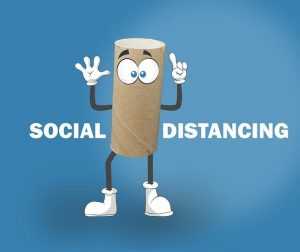The novel coronavirus SARS-CoV-2 which causes COVID-19 has taken over the news. For adults, the news is frightening. For children, it can be terrifying and may leave real scars. Parents can ease kids’ fears and help them cope with this pandemic, if they have the tools.
How can we, as parents and caregivers, help children understand this pandemic without living in constant fear of it? How can we support their developmental needs while helping them understand the COVID-19 coronavirus and the news surrounding it?
How can we share the hope of a bright future when the present seems so dark and scary?
Some very smart people have been thinking about these questions. I’ve been thinking about them, too.
I’m around children ages 6 and up in my facility daily. They see the world differently than adults and can often get overwhelmed by the onslaught of news, information and disinformation they are exposed to daily.
Here are some thoughts on how to help them through this challenging time.
Clear up the terminonlogy
Some of the terminology thrown around by the news media sounds terrifying, if you don’t understand it. Spend some time with your kids and ask them what they think some of those terms mean. Try questions like these. “What do you think COVID-19 is?” “What do you think the word ‘quarantine’ means?” “Do you know what ‘social distancing’ means?” The answers will help you understand what your child knows, what they don’t know and how they think about the disease.
Jennifer Rodemeyer, manager of the Child Life Program at Mayo Clinic, suggests clearly defining the terminology around COVID-19 coronavirus. There are key phrases and terms that, when clearly defined, will help your children cope better with what they are hearing.
COVID-19 – Your kids should know that this is a virus that can make them sick and cause them to feel sick. The symptoms include a cough, fever, chills and body aches. While they should know that these aren’t exclusive to COVID-19, it is important to tell you if they feel them, especially during this pandemic.
COVID-19 is so tiny that children can’t see it and won’t know it’s on their hands or on surfaces they touch. Since it can enter the body when we touch something that it’s on and then touch our faces, mouths or eyes, hand washing is really important. Keeping surfaces clean is also very important. Both of these practices are simple ways to give your children a measure, and a sense, of control over something that might hurt them.
COVID-19 can also enter the body through tiny droplets expelled when we cough or sneeze. So by covering their sneezes and coughs with a tissue or by coughing or sneezing into their elbow (called the “Vampire sneeze,”) they can help to limit the spread of the virus. Again, offering a technique for gaining control over a scary thing offers a sense of power they otherwise don’t have.
Explain that the reason this virus is everywhere in the news and on social media is because it’s new, or “novel.” Everyone on earth, including doctors, nurses and other health and medical professionals, are learning about it together. As they learn more, we’ll have more ways to limit its’ spread and how to treat it. Let your kids know that some of the smartest experts around the world are working as hard as they can to learn about the virus and keep us all safe.
 Social Distancing – This is a fairly new term that is being talked about everywhere. Medical and public health professionals are asking people to practice this in an effort to slow or stop the spread of the virus. It means avoiding close contact with other people when outside the home. It doesn’t mean avoiding contact with family members inside the home, unless they are ill.
Social Distancing – This is a fairly new term that is being talked about everywhere. Medical and public health professionals are asking people to practice this in an effort to slow or stop the spread of the virus. It means avoiding close contact with other people when outside the home. It doesn’t mean avoiding contact with family members inside the home, unless they are ill.
Rodemeyer suggests telling children to use the imaginary length of a bicycle as a means of understanding how far to stay from others in public. Instead of high fives, fist bumps or hugs, a simple wave may be better. What we also want our kids to know is that if the six-foot rule of social distancing is accidentally “violated,” they shouldn’t panic. It’s a guideline, not an iron-clad rule whose violation is cause for punishment or self-loathing.
Quarantine – This is just a scary word for anyone, but especially kids. Sub-conscious fears of isolation and abandonment go hand-in-hand with this one. Explain to your kids that quarantine may be as simple as staying in your house for a period of time up to 14 days. Let them know that only if they come in contact with someone who definitely has COVID-19 would they possibly need to be concerned about this. They also need to know it doesn’t mean they’d be separated from their family.
Build some new home routines to support your kids.
Giving kids the ability to predict what’s next gives them a sense of control and direction over the unknown. Post your family schedules and what, if any, different rules or guidelines need to be followed. If staying in the house is called for, make that clear, along with a clear explanation of why. Same thing for social distancing.
Help your kids feel accomplished by identifying clear expectations and acknowledging them when they meet those expectations. Include all important aspects of your children’s lives when establishing a schedule. What time is bedtime? When do they wake? Include meal times, household chores and responsibilities, outdoor play and exercise times, other play times and anything else that impacts their lives.
Stuck at home more? Play a little, or a lot!
Play is a great tool for teaching. It’s also a great tool for stress management and improving cognitive ability. Play will give your child the tools to help understand the nature of the COVID-19 situation and what they can expect for themselves. It will also give you time to interact with your kids and communicate with them in a low-pressure atmosphere. You may learn quite a bit about how they’re feeling!
Reading together, playing games, doing puzzles, exercising together, listening and playing music together and working on projects together will all provide great bonding and relaxation opportunities for the whole family. Try creating some theme nights like movie night, karaoke night, game night or indoor camping night. You have an opportunity to create some positive memories in the midst of a difficult time.
Use technology to connect with friends and loved ones
Your kids are most likely more tech-savvy than any other generation, maybe even more tech-savvy than you. Use that to help them connect and talk with grandparents, cousins, aunts, uncles and friends. Include the people they normally interact with, too. Using connectivity apps will allow your kids to keep and build relationships and avoid feeling isolated by talking to loved ones and people who matter to them.
Social games can also help. Many games and game systems have the capacity for children to play together even when they are far apart. Virtual play dates are a possibility. There are a myriad of ways that virtual connections can support your kids’ social development.
Cut off the constant stream of news
While we want our children to understand the COVID-19 virus and what it means for them, they don’t need 24/7 access to every news source. Explain to them that you are going to help them understand the realities of the virus by helping them find a small number of reliable news sources and then helping them absorb and understand what is being reported by them. The Centers for Disease Control, the Mayo Clinic, state and federal health agencies, Johns Hopkins University and a handful of others are examples of reliable, evidence-based news sources for the COVID-19 outbreak.
Cover the basics – and handle the unexpected
Teach your kids how to wash their hands. Give them fun tools to make sure they wash long enough. Singing the “ABC’s” or “Happy Birthday” twice while soaping up will ensure about 20 seconds worth of scrubbing. 
Hang signs in your home that say things like “Welcome home! Don’t forget to wash your hands first thing!” Tell them the times they should wash their hands: before meals, after using the toilet, after blowing their nose, coughing or sneezing and after being out of the house.
When an event your child was to attend gets cancelled, take the time to explain how that unhappy event will help stem the spread of COVID-19. Children will tend to see and appreciate an event from their own perspective. Letting them understand that this is a temporary way to help others will give them a fresh way to look at it. Let them know that when the COVID-19 virus is under control, those events will be safe to attend once again.
Who’s the boss?
Let your children know that when they are in someone else’s care, they should listen to that person. When a teacher, grandparent, caregiver, day care provider, etc. asks them to wash their hands or gives other hygiene instructions those instructions should be followed.
If the virus strikes, reassure them
If your child gets sick, remind them that they are being cared for by someone to whom they are infinitely important. Let them know you will be watching them and caring for them until they have recovered and that the best doctors are also caring for them.
If a friend or loved one gets sick, let your kids know that they are getting medical advice and care and are getting the best instructions on how to beat the virus and get better. Encourage your kids to send the afflicted person a note in the mail. Explain that receiving such a note will let the person know that others care for and are thinking about them and looking forward to when all of them can be together again.
Don’t lie
Parents often feel that a “little white lie” is okay when the truth my hurt or frighten your child, especially a younger child. While this may be true in some cases, be honest with your children about COVID-19. Letting your kids know that you’ll be honest with them and that being honest is important to you will build their trust. While your honesty may cause some worry or anxiety, the same truth-telling will make it easier to allay those fears or anxieties.
Have daily conversations with your kids about this. Let them know you’ll keep them up to date on changes regarding the virus. Let them know that you are the one to come to for new information and that they can ask you anything about the COVID-19 virus.
Share your own feelings about all that’s happening. Let them know that you have questions about COVID-19 and the situation. Share those questions with them, if appropriate. Let them know you are following the advice of some of the smartest medical and public health experts in the world and that their advice is going to help us all stay safe.
You are the authority in your children’s lives. In uncertain times, your kids need certainty, love, strength and a sense of control. I hope these ideas help you deliver those things for your children. I hope that you all stay safe, healthy and happy.
Keep the faith and keep after it!
 Bio: Coach Phil Hueston is not just another pretty trainer. With over 18 years of in-the-trenches experience with athletes ages 6 to 60, he brings a unique skill-set to the improvement of his athletes. The author of the Amazon best-seller “Alchemy; Where the Art and Science Collide in Youth Fitness,” his client list includes professional athletes, collegiate athletes as well as thousands of youth athletes. Phil has been the co-owner of All-Star Sports Academy in Toms River, NJ, one of the largest and most successful youth and family fitness centers in New Jersey since 2008. He was named “Coach of the Year” by the IYCA for 2012-2013. A contributor to IYCA.org and coach to other coaches, Phil provides unique insights and ideas that can help other coaches accelerate their clients’ progress and performance. Phil is married to the woman responsible for his entry into the fitness profession, MaryJo. Between them they have 2 grown children, Nate and Andrew, and 99 problems. Phil’s personal website is coachphilhueston.com, and he can be contacted at phil.hueston@hotmail.com
Bio: Coach Phil Hueston is not just another pretty trainer. With over 18 years of in-the-trenches experience with athletes ages 6 to 60, he brings a unique skill-set to the improvement of his athletes. The author of the Amazon best-seller “Alchemy; Where the Art and Science Collide in Youth Fitness,” his client list includes professional athletes, collegiate athletes as well as thousands of youth athletes. Phil has been the co-owner of All-Star Sports Academy in Toms River, NJ, one of the largest and most successful youth and family fitness centers in New Jersey since 2008. He was named “Coach of the Year” by the IYCA for 2012-2013. A contributor to IYCA.org and coach to other coaches, Phil provides unique insights and ideas that can help other coaches accelerate their clients’ progress and performance. Phil is married to the woman responsible for his entry into the fitness profession, MaryJo. Between them they have 2 grown children, Nate and Andrew, and 99 problems. Phil’s personal website is coachphilhueston.com, and he can be contacted at phil.hueston@hotmail.com
The IYCA High School Strength & Conditioning Specialist is the only certification created specifically for coaches training high school athletes, and it was recently updated to include even more information than ever. The course includes several hours of video instruction and two textbooks with contributions from some of the top strength and conditioning coaches in America. Click on the image below to learn more about how to become a certified high school strength & conditioning coach.


